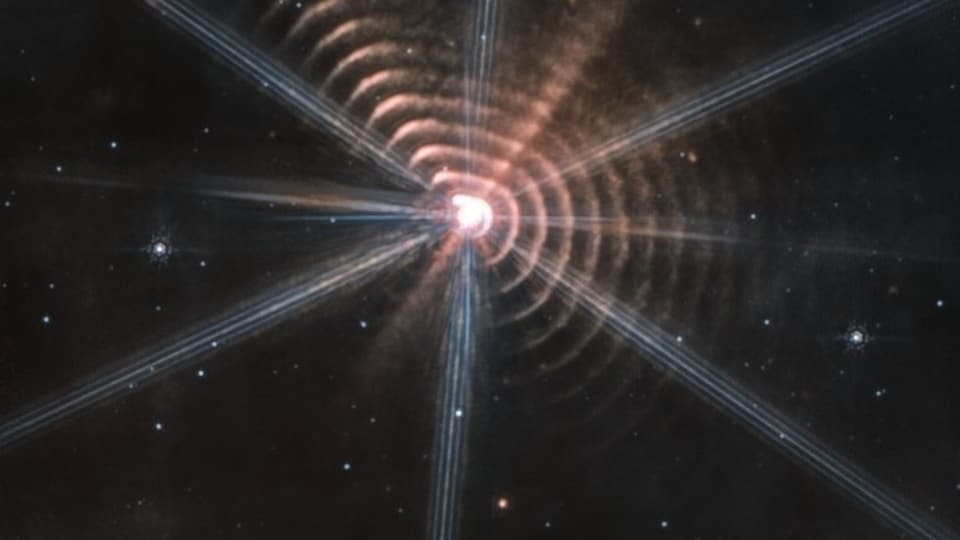
Nature Astronomy has just published a piece that exemplifies the type of research that the Webb Telescope is expected to accomplish. In the beginning, the new telescope was aimed at a pair of enormous stars in tight orbit around one another. It was already known from ground-based observations that these giants’ interactions formed at least one ring, but the Webb has since determined that at least 17 concentric rings of material have been set in place during the past 130 years.
Scientists have even managed to obtain a spectrum of the ring-forming substance, if only for bragging rights.
Examine the featured image at the top of this article for a visual representation of the strange appearance of these rings, the description of which falls far short of their true bizarro nature. However, a near-perfect reproduction of the structures can be made by simulating the forces that are assumed to have set them in place.
The two massive stars that make up WR 140 are part of a binary star system. Among the known classes of stars, the O-type is the largest and hottest. The second type of big star is known as a Wolf-Rayet, and it is so powerful that it blasts off most of its hydrogen and frequently releases carbon and nitrogen into space. It takes less than eight years for these two giants to complete one orbit of each other, despite the fact that their orbit is highly eccentric.
Both of these stars are quite active, and as a result, they produce strong stellar winds that propel a great deal of debris into space. Dust can form when the winds of two different systems collide and create a localised area of high pressure. The orbital dynamics cause a condensation pattern that resembles a ring, with most of the material condensing on one side of the pair. One or two rings, spanning around 5,000 times the distance from Earth to Sun, has been spotted by ground-based telescopes (called an Astronomical Unit, or AU).
Due to the intriguing nature of these structures, WR140 was selected as a priority for the Webb Director’s Discretionary Early Release Science Program. Images show a series of up to 17 rings, each one extending around a light year from the binary stars; they are very magnificent. It’s likely that there are further, fainter rings that reach far further.
Ring thickness varies across the structure. Webb’s mirrors and other components generate diffraction spikes, and these variations are superimposed on top of them. However, while the diffraction spikes are visible at all wavelengths, the ring features are significantly more visible at lower infrared energies.
In theory, the orbital interactions of the two stars govern the finer aspects of the rings, including their asymmetries. Consequently, the research team constructed a model that incorporates the specifics of the orbits of the two stars and the winds generated by them. A large number of the model’s predictions about the ring system in HR 140 have been confirmed as being spot-on. This indicates that our understanding of the physical forces responsible for forming this system is robust, including our ability to predict why there will be more dust at some places in the orbit than at others.
The current count of 17 rings suggests that ring formation has been going on for at least 130 years, if one ring is formed for every orbit. It may be deduced that they are receding from the binary stars at a rate of around 2,600 kilometres per second, given that they currently span roughly a light year.
Considering the ring material is subject to varying gravitational forces, radiation pressure from the stars, and drag from all the other material expelled by the stars, the expansion is remarkably even, notwithstanding minor imperfections.
Since the Wolf-Rayet star in WR 140 contains a lot of carbon, a good portion of the ring dust should include a lot of organic compounds as well. And the Webb’s hardware allows us to verify this. No individual molecules stick out in the spectrum, indicating that the chemical mixture is extremely complex. However, polycyclic aromatic hydrocarbons, which have rings like benzene, appear to be abundant. These are typical of carbon-rich Wolf-Rayet stars and develop in hydrogen-poor settings.
Since the laws of physics and chemistry are being strictly adhered to, there are not many puzzles to be solved. Knowing how part of the dust in the interstellar medium got there is important for other branches of astronomy, as it is known that dust in the ISM contributes significantly to star and planet formation.
However, it doesn’t mean you shouldn’t take a moment to marvel at the fact that the incredibly magnificent structures that Webb has unveiled can be produced by relatively simple chemistry and physics.



